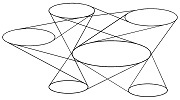


 |
 |
 |
| HOME |
Social deterioration is occurring everywhere. The cause is power mongering by incompetent persons. Agriculture Fraud Comes from all Directions South Dakota could feed the country organic food. The only reason it isn't is fraud. The supposed reason why California does the growing is its long growing season. Length of growing season is not relevant to very many products now days. The price of California doing it is growing on sandy soil which restricts growth due to texture and poor nutrients. South Dakota has ideal soil and climate for growing a large part of what people eat. It also has the last good source of irrigation water in the Missouri River. The attempt to pollute it with a pipeline project points to corruption with its related oppression, as going around the Missouri River would have been cheaper than going under it twice. On the east side is totally flat ground. Near the river are hilly river bluffs. Opponents won't mention going around the river, because they would be promoting carbon dioxide in the air. For the sake of fraudulent science, the river water is being polluted. It is not a question of if but when the pollution occurs, as opponents have been saying. Why were the corrupters forced to stay away from Bismarck? Because it is not a question of if but when the pipeline breaks. To irrigate hard ground effectively requires drip irrigation. It exists for warm climates but has not been developed for northern areas. Where the ground freezes in the winter, different procedures are required. Drip irrigation allows slow and continuous addition of water, so it has time to permeate through hard ground. And it reduces the amount of water that vaporizes into the air. It also has the advantage of allowing hilly ground to be irrigated. South Dakota soil is ideal for agriculture because it is very hard as fine textured clay. In the nineteenth century, soft ground was desired, because animals could not pull a plow easily through hard ground. Most thought patterns have not progressed to the benefits of hard ground. The primary benefit of fine textured soil is increased capillary action. Water and nutrients move toward the roots instead of requiring the roots to grow toward the water and nutrients. Sandy soil has no capillary action, and the result is very slow growth. Hard ground has to be broken up before roots can move through it, but it still maintains strong capillary action due to fine texture. A benefit of northern soil is that it freezes in the wintertime. Freezing breaks open most cells in the soil including bacteria, fungi and roots of non-perennial plants. That cell debris is acted upon by bacteria in the spring which have special enzymes for using the debris as food. These bacteria (most significantly, Pseudomonas fluorescens) are extremely symbiotic releasing the biomass to plants at just the right time in the spring. Early crops start to turn yellow in the spring due to a shortage of nitrogen, because bacteria hog up the nitrogen. Then the bacteria autolyze (self-destruct) and release their nitrogen to the plants. As these bacteria break down, they reduce large molecules to subunits—proteins to amino acids, and nucleic acids (genetic material) into nucleosides. The resulting molecules are ideal nutrients for plants. The plants get preconstructed molecules which frees up the cell machinery and energy supply for other purposes. The result is very rapid growth and superior flavor for food. On the plains, rain always comes with thunder storms. There is lightning with the thunder, and the lightning causes nitrogen in the air to be converted into nitrate. The nitrate comes down with the rain and endlessly resupplies the soil with nitrogen. These conditions allow organic agriculture to be produced very easily on the plains. Insects are seldom a problem in South Dakota, except where there is monoculture crops such as corn. With mixed crops, techniques such as rotation prevent insects from developing into a problem. Corn and soybeans could be replaced with more realistic crops for feeding livestock, which would allow organic meat to be produced. Ruminants, such as cows and sheep, did not evolve on starch; they evolved on cellulose. If the animals were fed cellulose instead of starch, they would produce less fat and grow slower, but agriculture would be greatly improved. Fat is not good for health; it is a rich man's luxury. Growing organic lean meat on cellulose should replace corn and soybean based agriculture. Feeding cellulose would require ten or twenty times fewer acres for the same result. There are other sources of protein for livestock than soybean meal. Beans which are low in oil could be sprouted and fed to livestock. The acreage would be reduced to about half compared to soybeans, which are grown for oil and livestock protein. People could learn to get by without the oil. It is possible to cook and eat better food without a drop of oil. Organic beef is almost non-existent, because corn is not produced organically on a large scale. Cellulose could easily be produced organically. Producing organic beef is becoming more important, because the new neonicotinoid pesticides do not break down, and they accumulate in the livestock. The old style organophosphate pesticides were rapidly broke down and were not concentrating in the livestock. Supposedly, neonicotinoids do not effect humans, because they have a methyl group on them. Santa Clause coming down the chimney is more credible. It's total propaganda. Neonicotinoids disrupt muscle control creating a variety of metabolic problems. Not only are they highly concentrated in meat, they accumulate in the human body for three to five days due to their absence of breakdown. Agriculture is moving in the opposite direction to promote genetically modified crops. The propaganda for GMOs tells us that improving yields and solving the problems of mankind should be the purpose of agriculture. Pretending that GMOs do that couldn't be a bigger fraud. There is no such thing as a GMO crop improving yields, because none of them were designed to do that. Only nature can improve the growth characteristics of plants, because the total integration of all properties are relevant. Altering one factor is a joke. It always reduces over-all productivity. And every GMO crop has been designed for some other purpose, such as resistance to herbicide. A twisted logic says that spraying more herbicide improves yield. About like bulldozing improves yield over carpet bombing. Resistance to herbicide has a labor-saving purpose, and nothing other than that. Otherwise, crops greatly benefit from tillage to kill weeds. Tillage kills all types of weeds, where GMOs leave resistant weeds. More importantly, tillage greatly improves growing conditions by breaking up the crust on the surface allowing oxygen and moisture to get to the roots and slowing evaporation and erosion. There is a fake line of research occurring in agriculture for the purpose of promoting the absence of tillage, called no-till. No-till was a theoretical concept for at least a century, but no one could find a use for it, until---until GMOs required it. Now no-till is supposedly the answer to everything. It gets a lot of research for the absence of something. The reason is because there is an unsolvable problem with no-till. It creates gully erosion. So endless research is being done to find ways of stopping gully erosion with no-till. You might think that no-till is good for everything being more natural than tillage. But it isn't natural. Crops are planted with it. With no-till, crops are planted in the previous year's residue, which creates problems. So, of course, greens get involved and claim no-till is necessary to keep carbon dioxide from entering the air through decay. One or two years of crop residue sitting on the surface is supposed to mean less CO2 in the air. Reducing the efficiency of agriculture is supposed to be a necessary price to pay for delaying some decay by one or two years. But lower efficiency agriculture puts more CO2 in the air by requiring more agriculture. The reason why no-till increases erosion is because it allows water to move more rapidly over the surface, both while the crops are growing and while the residue sits on the surface. Tillage integrates the residue into the soil near the surface slowing water movement and increasing absorption. While crops are growing, cultivation breaks the crust on the surface slowing water movement. But GMOs for corn or soybeans have the purpose of using herbicide to replace cultivation. There is no other purpose for herbicide resistant crops than to reduce the labor of not having to cultivate to get rid of weeds. Cultivation is how weeds were controlled before GMOs, and it was vastly superior by all criteria except requiring more labor. Why not create jobs tilling crops instead of spraying GMOs? What could be more capitalistic than having the government subsidize it? Because of the extremely warped information available, a lot of persons probably do not understand that weed spray existed long before GMOs. Historically, there have been two types of weed sprays. One type for killing broadleaf weeds, typically 2-4-D, and a type for killing grass-like weeds. GMOs allow broadleaf crops to be sprayed with one type of herbicide without harm, or they implant a bacterial toxin (BT) for killing bugs. These are not breakthroughs in agriculture. They are disputable purposes. The way some persons assume they are saving mankind with GMOs, they don't seem to understand that agriculture can do just fine without GMOs. South Dakota claims to produce the world's sweetest melons. The rind on South Dakota melons taste about like the inside of other melons. Most of the reason is because cold winters and hard ground provide preformed molecules to grow on. It would be like General Motors getting free engines to install in their autos. They would have a lot more cash to spend on other things, like caviar and Champaign. The flavor of food is greatly enhanced by preformed molecules available as plant food. Genetics, however, is also important in producing quality. Somehow, a totally different genetics goes with the South Dakota melons. The muskmelons are huge, about 8-12 lbs., with deep ribs. Someone decided that they should look like the melons in the stores, about like over-sized softballs. So they imported that type of genetics. And, abracadabra, it totally ruined the quality of South Dakota melons. Destroying genetics is the obsession of corrupters everywhere. Spices now days are about like dried leaves. You can't tell one spice from another anymore, because they are all about the same. That isn't what spices used to be. With corn, genetics is everything. Hybridizing requires mixing two parental types with many variations and picking out the result which has the right characteristics. To do this, thousands of parental types were used. Most of those parental types are now gone. They used to be grown in the mountains of Central America. It isn't happening any more, because Central American farmers have been driven out of business or forced to plant GMOs. Some corn hybridizing companies saved a few hundred parental types, but they no longer have the huge reservoir they once had. The seeds have to be regrown every few years, because they die rapidly in storage. South Dakota produce should cost less than California produce, because growing time is about one half or less, and no chemicals are needed. The flavor is immensely superior. Carrots and tomatoes bite back with flavor. Corrupters are trying to prevent South Dakota from being used for expanded agriculture by polluting the water.
|
|||||||||||||